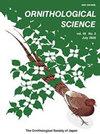Absence of Genetic Structure among Streaked Shearwaters Calonectris leucomelas Breeding in Japan, Despite Limited Dispersal Events
IF 0.3
4区 生物学
Q4 ORNITHOLOGY
引用次数: 0
Abstract
Abstract The genetic structure of Streaked Shearwater Calonectris leucomelas, a seabird breeding on islands around Japan, was investigated using nuclear microsatellite markers at four breeding colonies located in three geographically distinct areas (Pacific Ocean, Sea of Japan, and Seto Inland Sea). To investigate independently natal and breeding dispersal patterns, we analyzed records of recoveries of birds banded around Japan over a 30-year period from 1971 to 2020. The genetic marker analysis showed little differentiation among the breeding sites and a lack of population structure. In contrast, banding data presented few examples of natal and breeding dispersal and a much greater number of natal/breeding philopatry cases. Although further research is needed to understand the discrepancy between the genetic properties and recapture patterns of banded birds, some possible reasons are suggested: actual dispersal events may not have been fully detected by the banding research, thus, underestimating dispersal frequency; rare dispersal events may have functioned to reduce the genetic structure; and/or breeding colonies of this species might have been established recently, thus genetic markers may not be indicative of current dispersal patterns. In conclusion, our results indicate ongoing gene flow and/or strong historical association in this species.尽管分散事件有限,但在日本进行的条纹剪水Calonectris leucomelas育种中缺乏遗传结构
摘要利用核微卫星标记研究了在日本周边岛屿繁殖的斑剪水鸟(Streaked Shearwater Calonectris leucomelas)在太平洋、日本海和濑户内海三个不同地理区域的四个繁殖群体的遗传结构。为了调查独立的出生和繁殖扩散模式,我们分析了1971年至2020年30年间日本各地鸟类的恢复记录。遗传标记分析显示,繁殖地之间几乎没有分化,缺乏种群结构。相反,条带数据显示,出生和繁殖扩散的例子很少,出生/繁殖文献病例的数量要多得多。尽管还需要进一步的研究来了解带状鸟类的遗传特性和再捕获模式之间的差异,但有人提出了一些可能的原因:带状研究可能没有完全检测到实际的扩散事件,因此低估了扩散频率;罕见的扩散事件可能具有降低遗传结构的作用;和/或该物种的繁殖群体可能是最近建立的,因此遗传标记可能不能指示当前的传播模式。总之,我们的研究结果表明,该物种正在进行基因流动和/或存在强烈的历史关联。
本文章由计算机程序翻译,如有差异,请以英文原文为准。
求助全文
约1分钟内获得全文
求助全文
来源期刊

Ornithological Science
ORNITHOLOGY-
CiteScore
1.20
自引率
0.00%
发文量
26
审稿时长
>12 weeks
期刊介绍:
Ornithological Science publishes reviews, original articles, short communications and comments covering all aspects of ornithology. Manuscripts are judged on the basis of their contribution of original data and ideas or interpretation. All articles are peer-reviewed by at least two researchers expert in the field of the submitted paper. Manuscript are edited where necessary for clarify and economy. Ornithological Science aims to publish as rapidly as is consistent with the requirements of peer-review and normal publishing constraints.
 求助内容:
求助内容: 应助结果提醒方式:
应助结果提醒方式:


